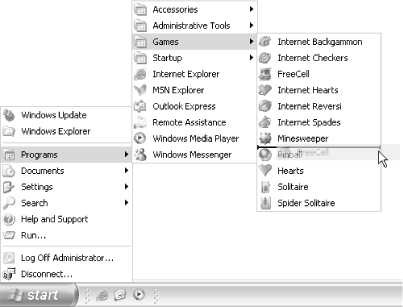Name
Start Menu
Synopsis
The central location for your application shortcuts and many Windows features.
To Open
Desktop → Start
Press the Windows logo key, if you’ve got one
Ctrl-Esc
The Start menu was one of Microsoft’s answers to the growing size and complexity of the Windows operating system when it was introduced in Windows 95. Since then, other features have been introduced to compensate for the Start menu’s inadequacies, such as the QuickLaunch toolbar and the new Windows XP-style Start menu. (See the discussion of “Style” at the beginning of this chapter).
Here is a quick rundown of the items you’ll find in the Start menu. Note that some of these items may be hidden as a result of settings described in Chapter 5. (Also see Figure 3-29.)

Figure 3-29. Start menu items can be rearranged by dragging and dropping
- Programs (or All Programs)
While the Desktop is commonly used to hold icons for the most frequently used programs, the Programs menu (or All Programs menu, with the new Windows XP style Start menu) is designed to hold icons for every program installed on your computer. See Shortcuts, earlier in this chapter, for details.
- Programs (or All Programs) → Startup
To have a program run automatically when Windows starts, place a shortcut to the program in this special folder. If you have more than one user set up on your computer, you’ll want to control whether the program starts up automatically ...
Get Windows XP in a Nutshell now with the O’Reilly learning platform.
O’Reilly members experience books, live events, courses curated by job role, and more from O’Reilly and nearly 200 top publishers.

